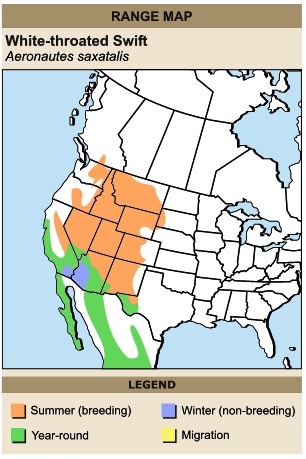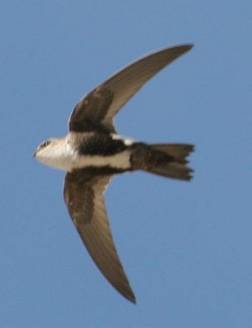|

Medium-sized swift,
mostly brown-black except for white throat, white patches
on belly, flanks, white edges on wings. Face is pale gray, has dark
eye patch. May be the most rapid flying North American bird, has been
seen fleeing from raptors at estimated speeds
of over 200 mph.

|
WHITE-THROATED
SWIFT
Aeronautes saxatalis
APODIFORMES
Swifts (Apodidae)
Range
and Habitat
Breeds from British Columbia through the Rocky Mountains and in the
southwest, including California. Spends winters from central California
and the southwest to Central America. Arid mountains or other rocky
areas are preferred habitats.
SOUND:
"jee-jee-jee-jee-jee"
The White-throated Swift was first described in 1853
by Samuel Washington Woodhouse, an American surgeon, explorer and naturalist.
It has proven to be extremely adaptable and will seek out crevices in
bridge trusses, highway overpasses, buildings, quarries and other manifestations
of human activity.
Adults exposed to prolonged cold, wet conditions may die. However, when
temperatures drop and food intake has been low, swifts become hypothermic
which may enable them to survive until conditions improve.
A group of swifts are collectively known as a "box", "flock",
"screaming frenzy", and "swoop" of swifts.
The White-throated Swift is a small swift found throughout western North
America and southward to western Honduras. During the winter months,
this bird will migrate to southern portions of its normal range.
They may be found as far north in the winter along the Pacific coast
as the Californian Central Valley. Inland populations extend through
the Great Basin and extreme southern British Columbia. Nests are built
high in the trees, as this bird is usually in flight versus on the ground.
Diets consist mainly of flying insects, berries and seeds.

|